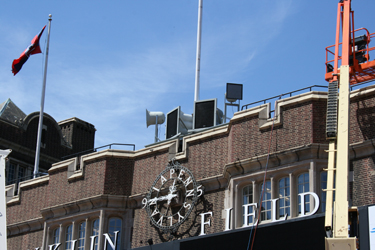Survival Materials

Part Two In The Outdoor Sound Saga Tests Loudspeakers’ Construction Mettle
by John Loufik
- In Nature the outdoor elements eat loudspeakers for lunch. Due to direct exposure to wind (oscillations), moisture, extreme temperature change, UV, and so forth, everything erodes outdoors faster than in sheltered environments. Worse yet, effects from the wind and corrosion due to weather exert and magnify very dynamic forces on the loudspeaker’s rigging (or mounting).
Therefore, careful attention must be given to all of the materials used in the loudspeaker’s construction and mounting to ensure an enduring system. Not all materials can simply be “weatherized” by applying an extra coat of paint, sealant, or other additive. In many cases, alternative, more rugged materials must be sourced in order to truly protect the loudspeaker at the component level rather than simply trying to seal a non-weatherized product and hope it will survive.
Beginning with the most important component in any loudspeaker, consider the materials used to fabricate the drivers (woofers, mid-range drivers, compression drivers, etc.). Better material choices include non-metallic (such as mylar), corrosion resistant metals such as titanium, and highly inert materials such as carbon fiber, or paper cone drivers treated with water sealants to shed moisture.

Yeadon, PA-based Clear Sound recently upgraded the aging sound system at the University of Pennsylvania’s Franklin Field with Community Professional R-Series weather-resistant loudspeakers powered by QSC amps. Clear Sound’s Chris Dietze said, “We’ve seen Community R-Series in sporting facilities, amusement parks and cruise ships all over the world, in some of the most brutal climates, and we have total confidence in their reliability.”
Most often, loudspeaker cabinets are constructed from wood products—particularly plywood. Can this be suitable outdoors? Yes if the wood itself has been treated for “marine use” and all of the cabinet internal and external surfaces (and joints) are fully encapsulated in an inert coating. Fiberglass external coatings and fiberglass resins have been proven over decades of use for this “encapsulation” process. Better yet, for ultimate weather resistance, what if the entire cabinet was constructed from fully seam-sealed inert materials such as polyethylene, fiberglass, plastic, etc.?
Not all powder-coated grilles and hardware are created equal. Powder coating offers excellent all-weather durability—until a scratch compromises this protective layer. Consider what lies beneath the powder coating. Is the steel galvanized or stainless steel? What grade of stainless? Is there some other secondary protective coating?
Since most transducers are not intended for direct exposure to the elements, loudspeaker grilles probably present the most difficulty in weatherizing as it must be acoustically negligible to the frequency response. Simple perforated steel grilles keep out larger foreign objects, but have little to no value for keeping out moisture. Adding cellular foam may help shed a mist, but not a driving rain. Multi-layer grilles with an internal fine mesh synthetic layer excel as the best solution to shed water so long as the mesh pattern prevents water ingress, but permits audio egress in an acoustically transparent manner. A truck-mounted 50-foot crane was brought in to mount two Community R2-77Z long-throw full-range and two R6-51 multi-driver vertical array systems.
Even if the cabinet, grille, and cable ingress will shed the elements, what about the internal electronics? Are they sealed with a marine quality coating to prevent corrosion on the crossover and switches? What’s That Spec?
Beware that no regulatory body governs the specifications of outdoor rated loudspeakers. Manufacturers are self-regulated. Specifiers can find some reassurance about a loudspeaker’s suitability by examining product specifications for Mil Spec and IP Ratings.
Military Specifications require third-party testing and verification regarding a variety of endurance/durability tests that must be made on a given type of product. These tests include standardized accelerated life testing for UV exposure, rapid change in extreme heat and cold conditions, vibration, salt water exposure, etc. Before and after the accelerated life testing, a given product’s electro-acoustic performance must be measured and documented. The loudspeaker must maintain audio performance within a close tolerance to its original performance. It also must not exhibit any evidence of structural compromises that might indicate a safety risk or prematurely shortened product life.
IP Ratings were developed to indicate the level of protection against ingress of moisture and foreign matter into electrical hardware components. Be aware, however, that IP ratings do not require verification by a third-party testing lab as manufacturers are self-regulated when presenting IP specifications. Moreover, there are no standard test procedures to follow such as are stipulated for Mil Specs. Note that rating numbers that appear to be higher than others do not automatically mean that they are better as the manufacturer has the opportunity to define the IP based on the instructed manner of use.
--JL
A daily selection of the top stories for AV integrators, resellers and consultants. Sign up below.
Residents in northern climates might be well acquainted with keeping warm in the winter, but did you know that loudspeakers can also begin to fail due to extreme old? Magnetism in the transducer magnet assembly can become permanently weakened at temperatures approaching or exceeding minus 30 degrees F. If the sound system will ever be exposed to such low temperatures in use or in storage for any period of time, provisions must be made to keep the loudspeakers warm.
In warmer climates, excessive heat presents conditions ideal to create power compression which yields reduced output as the driver’s internal structure becomes electrically less efficient due to thermal effects in the voice coil and electronics. For these conditions, cooling the driver may not be possible, but selection of drivers with cooling features such as ferro-fluid or full air exchange within the voice coil gap will help. Consider simply over-sizing the system to have sufficient acoustic output headroom to afford SPL loss due to power compression. Also, cabinet materials and finishes can be selected to help insulate the drivers from solar radiation.
Underestimating the effect of wind on the rigging plan can easily lead to a mount failing under the constant bombardment of repetitive oscillation forces. While most elements of a safe rigging plan for indoor systems focus on supporting static loads, outdoor systems require special attention to dynamic loads that magnify far beyond the simple “dead” weight of the loudspeaker(s). Specialized rigging designs must be adopted by experienced rigging fabricators. The appropriate locally licensed mechanical engineer should approve their designs.
Successful outdoor loudspeaker systems add an important dimension to entertainment and communication for a wide variety of audiences. Observing the common challenges described above will help prevent costly errors. There are many other important aspects to consider such as wind shear, humidity’s effect on speed of sound, wire paths, loudspeaker cable losses, and boundary diffraction. Be sure to research all of the conditions that may affect the systems you implement. Seek assistance with any factors that present challenges new to you that might compromise the system’s design and safety. When in doubt, plan for the worst and hope for the best!

The AVNetwork staff are storytellers focused on the professional audiovisual and technology industry. Their mission is to keep readers up-to-date on the latest AV/IT industry and product news, emerging trends, and inspiring installations.
